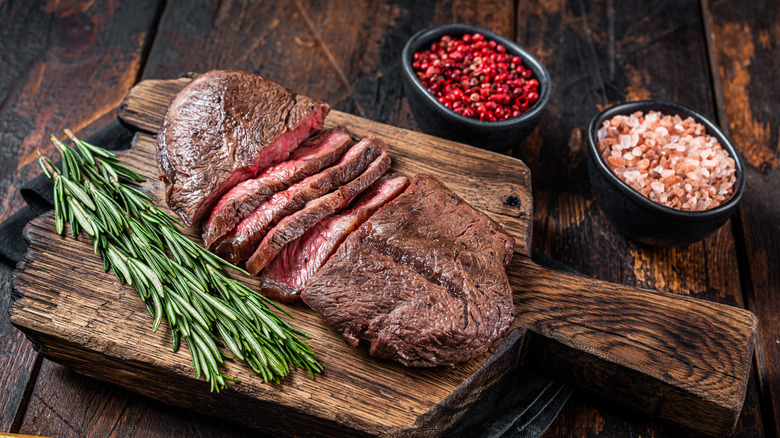Jacques Pépin's Favorite Cut Of Meat For His Classic Beef Stew
When Jacques Pépin talks, food lovers around the world listen. The undisputed master of simple, French cooking has been dispensing culinary knowledge for decades to help cooks get the most out of every ingredient and kitchen tool, like getting the most out of a stalk of asparagus or testing knife blades with ripe tomatoes. So if you're hankering for a batch of beef stew but you're not sure which cut of beef to use, go for Pépin's favorite: Flatiron steak. In multiple appearances on his public television shows, he has sung the praises of this often overlooked (and frequently inexpensive) cut of beef, and you should give it a try.
With any beef stew recipe, it's important to choose meat that can stand up to the long, slow, moist heat. Normally at the grocery store, you'll find stew meat taken from the chuck, which is in the upper shoulder and neck area of the animal, or the round, which is in the rear hind quarter. The flatiron, however, comes from the shoulder between the shoulder blade and top blade and is an excellent choice for everything from stews to steaks because it's very lean but has some intramuscular marbling, which will keep the meat tasting moist even after hours in a slow cooker or Dutch oven.
Shop for flatiron steak
If you're ready to make a Jacques Pépin-worthy beef stew, the first step is shopping for flatiron steak. The cut is often sold under a couple of different names, including "top blade," "blade steak," and "chuck eye," but they are all the same thing. It's also not the most common cut in most grocery stores, and even if it's available it's probably next to the ribeyes and not the stew meat.
If you can't find flatiron in your local supermarket, there are a few options: Talk to the folks at the meat counter or approach someone stocking the meat cooler. If you ask for flatiron, chances are they'll be able to help you locate it already in the cooler, or they can cut some for you in the kitchen. If they don't know what you're talking about, ask for blade steak or chuck eye and see if that helps. If the supermarket isn't an option, head to a specialty butcher and ask at the counter. If they don't have any flatiron steak on hand, ask if they can order it.
If you're already at the store faced with cuts of flatiron steaks, look for pieces that have even marbling throughout, which are the white flecks of fat interspersed in the muscle fiber. Once you get it home, slice it into fork-sized chunks against the grain, and it's ready to use in any recipe for beef stew.

